First post, by aquishix
- Rank
- Member
So, I've got 3 vintage gaming rigs that I'm building right now.
Relevant specs:
1) AMD386DX40 w/ 8MB of RAM
2) Intel 486DX2/66 w/ 16MB of RAM
3) Intel Pentium II @ 350MHz w/ 128MB of RAM
I've only been able to acquire one Gravis Ultrasound card, and it's a non-PnP model(thank GOD), so it'll be possible(or at best, easier) to get it working on the 386 or 486. It works perfectly in the Pentium II system despite the difficulties with the installer program.
-- The 1st question is: If I had to stick the GUS card in only one system and leave it there, which one makes the most sense? --
My experience and knowledge on this suggests it would be the 486, because that seems to overlap best with the time period in which Gravis was relevant and games were written to target the GUS cards. I could also put it in the 386 for similar reasons, but it seems like there'd be fewer playable games if I did that. This is a question that I want people to weigh in on that have significant, recent experience using GUS cards with DOS games on 386s and 486s. =)
-- The 2nd question is: Whether or not the GUS ends up in the 386, is it even worth it to put a SB16 card in the 386? --
I've read Phil(of PhilsComputerLab) state that the SB Pro is the best card for early DOS games because 16-bit samples weren't used until much later in the game -- which sounds like the 486 and early Pentium era. I've got a Sound Blaster Pro 2.0 that I could put in this 386. I have enough slots and free resources where I could conceivably have the SB Pro, GUS, and an SB16 all in the same system working together.


